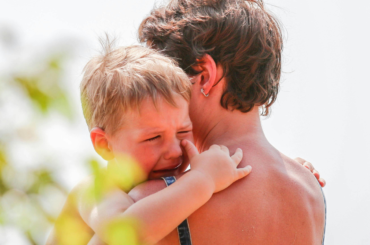Kids today have more access than ever before to the internet — and all of the problematic and complicated things that come along with it. Unfortunately, these days it’s practically inevitable that your child will eventually come across pornography online, or even look it up themselves if they’re curious. While curiosity is completely natural, early exposure to pornography (for boys especially) has been associated with increased violence and aggression towards women, sexual addiction, and consumption of illegal child sexual abuse images as an adult.
Access to porn is extra concerning when it replaces comprehensive and health-focused sex ed for kids, so it’s helpful for parents to both think ahead about how they’ll handle the situation when it arises, and allow their kids to participate in comprehensive sex ed if it’s offered at their school. In fact, most data suggests the average age of first exposure to online porn is between 9 and 11, and kids this age often describe porn as “gross,” “uncomfortable,” and “confusing.” So you’ll want to prepare yourself with some talking points starting younger than you probably thought.
Lead with emotional neutrality
First, it’s important not to blame yourself or your kid if they view porn online. Most kids initially see pornography unintentionally. They might encounter porn by clicking an ad, opening a spam email or text, typing in a web address incorrectly, or even doing a web search for a nonsexual term that may actually have a sexual meaning. If they did seek it out, it was most likely out of curiosity, which is perfectly natural for kids.
Prepare yourself to start the conversation from a place of neutrality and non-judgment. Kids are less likely to listen and feel comfortable talking if emotions are heightened. Even worse, reacting with anger or other strong negative emotions can inadvertently instill shame in your child around bodies and sexuality, which can be challenging to overcome later.
It may be hard to shake the initial emotions that come up when you learn your child has been exposed to pornography, so giving yourself space to take some deep breaths and think about what you’re going to say can be really helpful in the moment. It can also help to have the conversation in a more casual setting, especially one where you’re not required to sit face to face, like during a drive, out on a walk, or while doing chores together. Settings like these can make the talk feel less confrontational and lower the stakes a bit to put kids at ease.
You can say, “It’s okay to tell me what you saw. You will never get in trouble for coming to me about something you saw online.”
Use open-ended questions
This tip is especially helpful for parents of younger kids who may not have learned much, or anything, about sex yet. Rather than lecturing or explaining in detail what they saw, it can be helpful to start with open-ended questions and let them fill in the blanks. Leave lots of space for them to ask their own questions and express their feelings.
Letting them lead the conversation is a great way to avoid over-explaining topics they already know about or aren’t quite ready for. It’s also a great way to uncover their reasons (if any) for viewing explicit material. For example, they may have come across it accidentally, they might have overheard a term used by older kids and wondered what it meant, wanted to check out some info about puberty that they’d been discussing with friends, or they might have been introduced to a sexual topic by a “friend” they just met on the internet — and each of these scenarios will give you a better idea of how to proceed, and how to protect your child going forward.
Use the correct biological terms like “penis” and “vulva” when talking about pornography, and be sure to answer your kid’s questions directly and confidently. Showing them that you aren’t afraid to talk about sex and pornography will make them feel less shame — and less fear about coming to you with questions or problems in the future.
You can say, “What did you see that was confusing to you?” or, “How did you feel about what you saw?”
Put it in context
Explain that most porn on the internet is not an accurate depiction of how adults have sex. Much of the porn online is performed by professional actors, and is often catering to a largely male audience by focusing primarily on the pleasure of men. Women are often objectified in porn, and important aspects of safe sex like consent and contraceptives are rarely depicted. Explain to your kid that what they saw is meant to be a fantasy and is not how sex works in real life.
You can say (if age-appropriate), “What you saw is not how most adults have sex. In real life, sex is about making each other feel good, not performing or looking ‘hot.’ It’s also very important to get enthusiastic consent and practice safe sex, which you don’t usually see in porn.”
Set some boundaries
Once you’ve talked through what they’ve seen without shame or judgment, it’s time to set some boundaries around what is and isn’t okay to look at online. Remind them about steps they can take to stay safe on the internet, such as not clicking pop-up ads or links from unknown sources. Then, take some time to revisit the parental controls on their devices and favorite apps.
You can say, “If you see something online that makes you feel icky, scares you, or that you think kids probably shouldn’t see, it’s important for you to tell me or another adult you trust right away.”
Make it an ongoing conversation
As Dr. Gail Dines, president of a nonprofit called Culture Reframed put it, “Don’t have one 100 minute conversation about porn, but 100 one-minute conversations.” Just like the “sex talk”, the “porn talk” is not a one-and-done conversation. Reinforcing this open-door policy of communication can make all the difference when your kid encounters something problematic online.
Look for opportunities to check in about their online activities or their exposure to sexual materials. You’ll also want to normalize any feelings of embarrassment, curiosity, or arousal they might experience. Refraining from using shame will help them feel more comfortable talking to you openly when the time comes. There are some great age-appropriate books you can add to your home library to help facilitate these conversations.
You can say, “The internet isn’t a good place to learn about sex, so if you ever have any questions or don’t understand something, you should always come to me. You can even leave your question on a note if that feels easier.”







